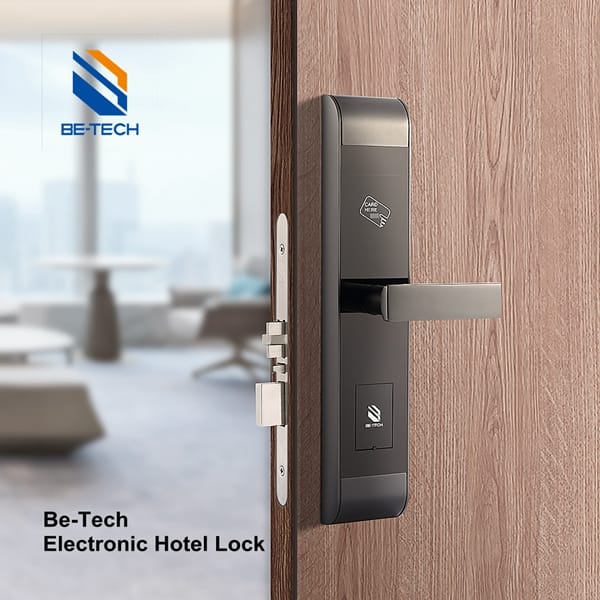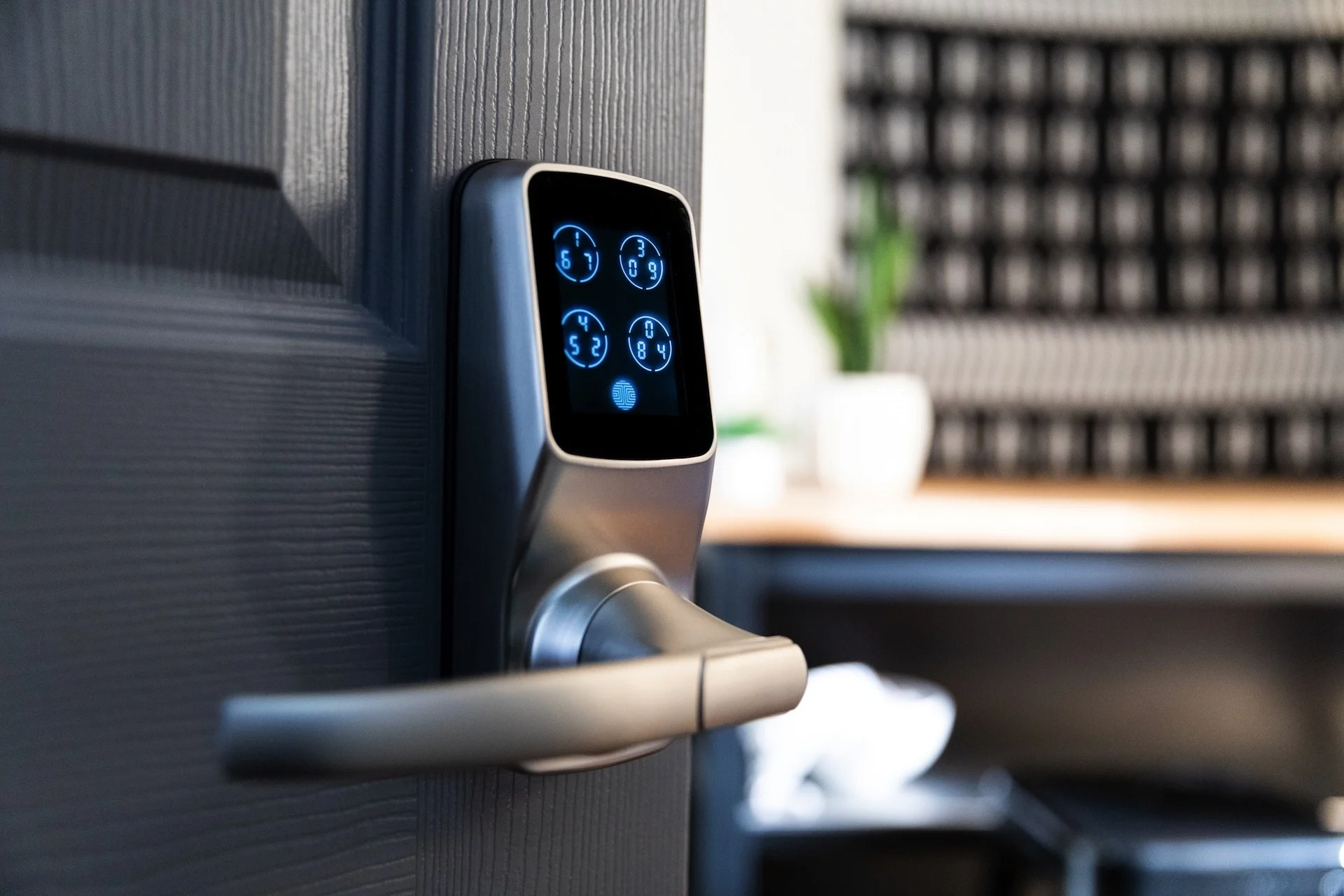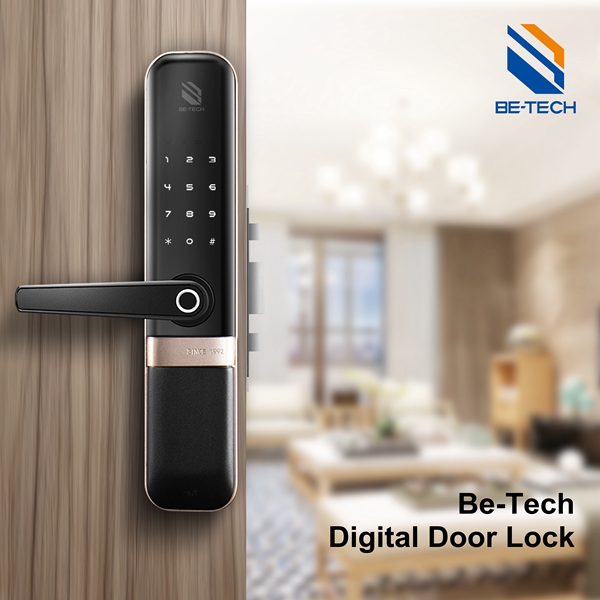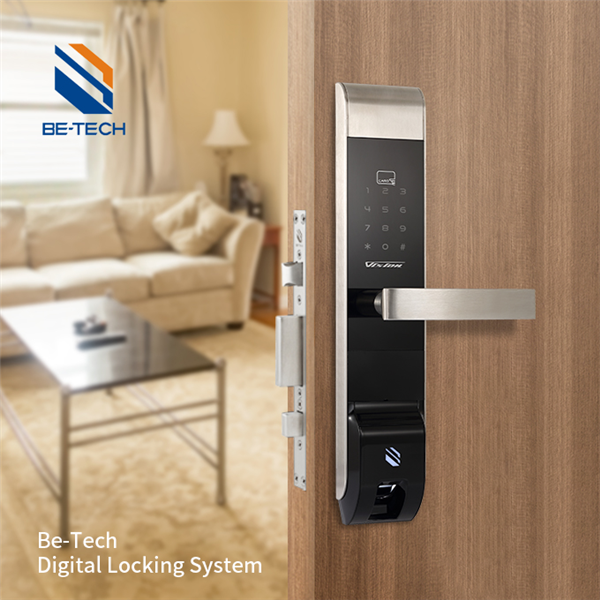In our increasingly connected world, home security is evolving rapidly, with smart locks leading this transformation. Traditional keys are becoming obsolete as smart locks offer homeowners and businesses enhanced security, unparalleled convenience, and precise control over property access.
The global smart lock market is experiencing explosive growth. According to a recent report by MarketsandMarkets, it is projected to reach $3.9 billion by 2025, with a compound annual growth rate (CAGR) of 13.1%. This surge is driven by several factors:
- Growing demand for seamless access control
- Advanced security features
- Integration with smart home ecosystems
This comprehensive guide will unlock the world of smart locks by exploring their cutting-edge features, myriad benefits, diverse types, and crucial factors to consider when selecting the ideal smart lock for your needs in 2024.
Understanding the Fundamentals of Smart Locks
What Defines a Smart Lock?
A smart lock is an advanced electromechanical locking device that enables users to control access to a property using various authentication methods, including:
- Smartphone Apps: Remotely lock and unlock your door using a dedicated mobile application.
- Keypads: Enter a unique PIN code on a digital keypad for entry.
- RFID Cards or Tags: Tap a programmed card or tag against the lock’s reader to gain access.
- Biometric Authentication: Utilize fingerprint or facial recognition technology for enhanced security.
- Voice Commands: Integrate with popular voice assistants like Alexa, Google Assistant, or Siri for hands-free control.
The Inner Workings of Smart Locks
A smart lock replaces or augments your traditional door lock, incorporating several key components:
- Actuator: An electromechanical motor that physically moves the deadbolt or latch to lock and unlock the door.
- Microprocessor: The brain of the smart lock, responsible for processing commands and controlling the actuator.
- Communication Protocol: Smart locks utilize various wireless technologies such as Bluetooth, Wi-Fi, or Z-Wave to communicate with smartphones and other smart home devices.
- Power Source: Most smart locks are battery-powered for easy installation, while some models offer hardwired options for continuous power.
Cutting-Edge Features and Access Technologies
Modern smart locks boast an impressive array of features that enhance security, convenience, and control over property access. Here are some key features and access technologies to consider:
Keyless Entry: Eliminate the need for physical keys and enjoy the convenience of unlocking your door using your smartphone, a PIN code, or an RFID card.
Remote Access: Lock and unlock your door from anywhere in the world using a smartphone app, grant temporary access to guests, and receive real-time notifications about lock activity.
Customizable Access Schedules: Create tailored schedules to grant or restrict access at specific times, ensuring only authorized individuals can enter during designated periods.
Comprehensive Audit Trails: Track a detailed history of who has accessed your property and when, providing valuable insights for security and management purposes.
Flexible Guest Access: Generate time-limited PIN codes or grant temporary app-based access for guests, cleaners, or service providers.
Auto-Lock Functionality: Set the lock to automatically secure itself after a predetermined time, ensuring your door is always protected.
Seamless Smart Home Integration: Connect your smart lock with other smart home devices to create a cohesive ecosystem for controlling security, lighting, temperature, and more.
Table: Comparing Smart Lock Access Methods
| Access Method | Pros | Cons |
|---|---|---|
| Smartphone App | Convenient remote access, guest management, activity notifications | Requires a smartphone and stable internet connection |
| Keypad | Easy to use, no smartphone required | PIN codes can be forgotten or potentially observed |
| RFID Card or Tag | Quick and contactless access | Cards can be lost or stolen |
| Biometric (Fingerprint/Face) | Enhanced security, difficult to forge | May be affected by environmental factors |
| Voice Commands | Hands-free convenience | Requires integration with a voice assistant, potential privacy concerns |
Diverse Types of Smart Locks
The smart lock market offers a variety of options to suit different needs and preferences:
Deadbolt Smart Locks: The most common type, replacing existing deadbolts for enhanced security. Examples include the August Smart Lock Pro and the Schlage Encode.
Smart Knob Locks: Ideal for interior doors, these replace traditional doorknobs with smart lock mechanisms. The Level Lock is a popular option in this category.
Lever Handle Smart Locks: Similar to knob locks but designed for doors with lever handles. The Yale Assure Lever is a well-regarded choice.
Smart Safes: These provide secure storage for valuables while incorporating smart features like biometric access and detailed audit trails. Be-Tech’s GUARD series of digital hotel safes exemplifies the advancements in this technology, featuring an industry-leading audit trail system and innovative components like “Smart Package” and “Smart Button Key.”
Smart Padlocks: Portable locks offering keyless convenience for securing luggage, lockers, or other personal belongings. The Tapplock one+ is a notable example.
Smart Travel Locks: Specifically designed for luggage, these TSA-approved locks allow for easy access by airport security personnel while providing keyless convenience for travelers. The Benjilock TSA Travel Lock is a popular choice in this category.
Selecting the Ideal Smart Lock: Key Considerations
Choosing the right smart lock requires careful evaluation of your specific needs and priorities. Consider these crucial factors:
Security Features:
- ANSI/BHMA Grading: Opt for locks that meet or exceed ANSI/BHMA (American National Standards Institute/Builders Hardware Manufacturers Association) standards for security and durability. Grade 1 offers the highest level of security.
- Encryption: Ensure the lock utilizes robust encryption protocols (e.g., AES 256-bit) to protect communication between your smartphone and the lock.
- Tamper Resistance: Look for features like anti-drill plates, tamper alarms, and pick-resistant cylinders to deter physical attacks.
Access Methods:
- Smartphone App: Evaluate the app’s user interface, features, and compatibility with your device’s operating system. Look for apps with high ratings and regular updates.
- Keypad: Choose a keypad with backlit keys for easy visibility in low-light conditions. Consider models with anti-smudge technology to prevent wear patterns that could reveal frequently used numbers.
- Biometric Authentication: Assess the speed and accuracy of fingerprint or facial recognition technology. Look for locks with low false acceptance and false rejection rates.
Connectivity:
- Bluetooth: Provides a secure, short-range connection suitable for most homes. Look for Bluetooth 5.0 or later for improved range and energy efficiency.
- Wi-Fi: Offers greater range and remote access capabilities but may require a separate hub or bridge. Consider the impact on your home’s Wi-Fi network and the lock’s power consumption.
- Z-Wave: A reliable protocol for smart home integration, but requires a Z-Wave compatible hub. Ideal for those building a comprehensive smart home ecosystem.
Power Source:
- Battery-Powered: Most common, with battery life ranging from several months to a year. Look for locks with low-battery alerts and easy battery replacement procedures.
- Hardwired: Offers continuous power but requires professional installation. Consider this option for high-traffic areas or commercial applications.
- Backup Power: Prioritize locks with emergency power options, such as a 9V battery terminal or a concealed physical key override.
Installation and Compatibility:
- DIY-Friendly: Most smart locks can be installed using basic tools. Look for locks with clear installation instructions and video tutorials.
- Professional Installation: Consider professional installation for hardwired locks, complex integrations, or if you’re uncomfortable with DIY projects.
- Door Compatibility: Ensure the lock is compatible with your door’s thickness, backset, and existing hardware.
Aesthetics and Design:
- Style and Finish: Choose a lock that complements your door’s style and your home’s overall aesthetic. Many manufacturers offer multiple finishes to match existing hardware.
- Size and Profile: Consider the lock’s size and how it will look on your door. Some smart locks have a more prominent profile than traditional locks.
Brand Reputation and Support:
- Reputable Manufacturers: Opt for well-established brands known for quality, security, and customer support. Research the company’s track record in the smart lock industry.
- Warranty and Customer Service: Look for locks with comprehensive warranties and responsive customer support channels.
- Software Updates: Choose brands that provide regular firmware and app updates to address security vulnerabilities and add new features.
User Reviews and Expert Opinions:
- Consumer Reviews: Research online reviews from verified purchasers to gain insights into real-world performance, reliability, and potential issues.
- Expert Evaluations: Consult professional reviews and comparisons from reputable technology and security websites.
Tip: Always prioritize security features and choose a lock that meets or exceeds industry standards. Remember that the most feature-rich lock may not always be the most secure option for your specific needs.
Advantages of Smart Locks: Enhancing Security and Convenience
Smart locks offer a compelling set of benefits that elevate both security and convenience:
Enhanced Security:
- Keyless Entry: Eliminates the risk of lost or stolen keys, providing greater control over access and reducing the likelihood of unauthorized key duplication.
- Remote Monitoring: Allows real-time monitoring of lock activity from anywhere, ensuring your property is secure even when you’re away.
- Temporary Access Management: Grant and revoke temporary access codes for guests, service providers, or family members with precise control over duration and permissions.
- Automatic Locking: Ensures your door is always secured, preventing accidental security breaches due to forgetfulness.
- Integration with Security Systems: Many smart locks can be integrated with broader home security systems, triggering alarms or notifications in case of unauthorized entry attempts.
Unparalleled Convenience:
- Keyless Freedom: Enjoy the convenience of never having to carry or fumble with physical keys again.
- Remote Access Control: Lock or unlock your door from anywhere in the world, providing peace of mind and flexibility for managing access.
- Customizable Access Schedules: Set tailored schedules to grant or restrict access at specific times, streamlining access control for family members, employees, or guests.
- Smart Home Ecosystem Integration: Connect your smart lock with other smart home devices for a seamless and automated home experience, such as disarming your security system when you unlock the door.
Enhanced Awareness and Control:
- Real-Time Notifications: Receive instant alerts on your smartphone whenever your lock is accessed, keeping you informed of all activity at your property.
- Detailed Access Logs: Review comprehensive logs of lock usage, providing valuable insights for security, property management, or parental monitoring.
- Voice Control: Integrate with popular voice assistants for hands-free operation, adding an extra layer of convenience to your daily routines.
Addressing Common Concerns About Smart Locks
While smart locks offer numerous benefits, it’s important to address common concerns:
Battery Life: Most smart locks offer long battery life, typically lasting 6-12 months with normal use. To alleviate concerns:
- Choose locks with low-battery alerts sent to your smartphone.
- Look for models with easy battery replacement procedures.
- Consider locks with backup power options, such as a 9V battery terminal or physical key override.
Temperature Sensitivity: Extreme temperatures can potentially affect smart lock functionality. To mitigate this:
- Select locks designed for a wide temperature range, typically -22°F to 140°F (-30°C to 60°C).
- Look for locks with weather-resistant seals and coatings to protect internal components.
- Consider installing a protective cover or awning over exterior-facing smart locks in harsh climates.
Security Vulnerabilities: As with any connected device, security is a paramount concern. To enhance smart lock security:
- Choose locks from reputable manufacturers with a strong track record in security.
- Ensure the lock uses robust encryption protocols (AES 256-bit is the current standard).
- Regularly update your lock’s firmware and associated smartphone app.
- Use strong, unique passwords for your smart lock app and associated accounts.
- Enable two-factor authentication when available.
Expert Insight: “While smart locks introduce new convenience, they also present potential cybersecurity challenges. Unlike traditional locks, smart locks have digital interfaces that could be vulnerable to hacking attempts. However, by choosing reputable brands, keeping software updated, and following best practices for password management, users can significantly mitigate these risks and enjoy the benefits of smart lock technology.” – John Smith, Cybersecurity Expert at SecureTech Solutions
Tip: When selecting a smart lock, prioritize models from established manufacturers who demonstrate a commitment to ongoing security updates and have a proven track record in addressing vulnerabilities promptly.
Future Trends in Smart Lock Technology
The smart lock industry is rapidly evolving, with several exciting trends shaping the future of home and business security:
Advanced Biometric Authentication:
- Next-generation fingerprint sensors with improved accuracy and speed.
- 3D facial recognition technology for enhanced security and convenience.
- Multi-factor biometric authentication combining fingerprint, facial, and even iris scanning.
Artificial Intelligence Integration:
- AI-powered smart locks that learn user behavior patterns and adapt security settings accordingly.
- Predictive maintenance alerts based on usage patterns and lock performance data.
- Advanced anomaly detection to identify and flag suspicious access attempts.
Enhanced Connectivity and Interoperability:
- Adoption of new wireless protocols like Thread and Matter for improved smart home integration.
- Increased compatibility with various smart home ecosystems and voice assistants.
- Development of mesh networks among multiple smart locks for extended range and reliability.
Sustainable and Energy-Efficient Designs:
- Integration of energy harvesting technologies to extend battery life or potentially eliminate the need for batteries.
- Use of recycled and eco-friendly materials in lock construction.
- Implementation of power-saving modes and more efficient communication protocols.
Improved User Experience:
- Gesture-based controls for hands-free operation.
- Augmented reality (AR) interfaces for easier installation and troubleshooting.
- Customizable LED displays for visual feedback and personalization.
Enhanced Security Features:
- Integration of blockchain technology for tamper-proof access logs and enhanced encryption.
- Adoption of quantum-resistant cryptography to future-proof against potential quantum computing threats.
- Development of “invisible” smart locks that blend seamlessly with door designs for improved aesthetics and security.
As these trends continue to shape the smart lock landscape, consumers can expect even more secure, convenient, and intelligent access control solutions in the coming years.
Conclusion: Embracing the Smart Lock Revolution
Smart locks are at the forefront of the home security revolution, offering a compelling blend of enhanced protection, unparalleled convenience, and seamless integration with modern lifestyles. As technology continues to evolve, smart locks will become increasingly intelligent, secure, and user-friendly, transforming the way we interact with our homes and businesses.
By carefully considering your specific needs, prioritizing security features, and staying informed about the latest advancements in smart lock technology, you can confidently choose a solution that not only meets your current requirements but also adapts to future innovations in home automation and security.








